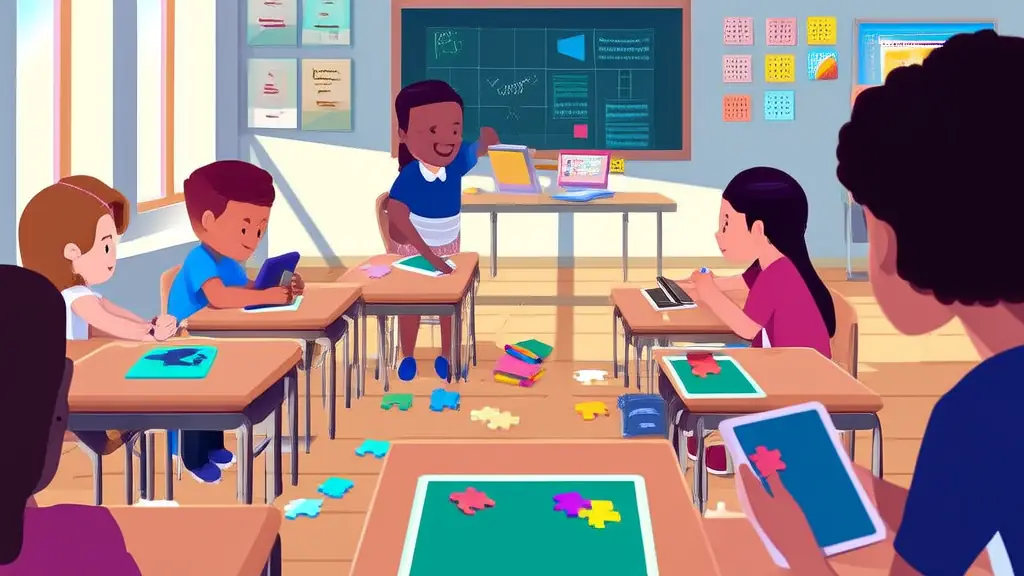
www.uitgedu.com | 自然英语拼读 | KET | PET | 英语点读学习资料
Shaping the Future: Navigating K-12 Education in 2025
Welcome to the ever-evolving world of K-12 education, where the landscape is constantly being reshaped by innovative teaching methodologies, groundbreaking research in child development, and the transformative power of technology. As we stand at the midpoint of 2025, it's an exciting time to be a part of this dynamic field. Whether you're a parent looking to support your child's learning journey or an educator striving to make a difference, this post will provide valuable insights, practical tips, and inspiring success stories to help you navigate the educational terrain.
Latest Teaching Methodologies and Their Effectiveness
In recent years, traditional teaching methods have been complemented—and sometimes replaced—by more student-centered approaches. One such method gaining traction is project-based learning (PBL). PBL encourages students to engage in real-world problems, fostering critical thinking, collaboration, and problem-solving skills. For example, a high school in California implemented a PBL program where students worked on a project to design sustainable housing solutions. The results were impressive: not only did the students develop a deep understanding of the subject matter, but they also gained valuable life skills that are essential for their future careers.
Another effective methodology is blended learning, which combines face-to-face classroom instruction with online learning. This approach allows for personalized learning experiences, as students can progress at their own pace and receive immediate feedback. A study conducted by the Clayton Christensen Institute found that blended learning models can lead to significant improvements in student achievement, particularly in math and reading.
Child Development Insights and Research
Understanding child development is crucial for creating effective learning environments. Recent research has shed light on the importance of social-emotional learning (SEL) in the K-12 setting. SEL focuses on developing students' self-awareness, self-management, social awareness, relationship skills, and responsible decision-making. Schools that integrate SEL into their curriculum have seen positive outcomes, including improved academic performance, better behavior, and reduced emotional distress.
Additionally, the concept of growth mindset has gained widespread recognition. Developed by psychologist Carol Dweck, the growth mindset emphasizes the belief that abilities and intelligence can be developed through dedication and hard work. Educators who foster a growth mindset in their classrooms create an environment where students feel empowered to take on challenges and learn from mistakes. For instance, a middle school in New York implemented a growth mindset program, and within a year, there was a noticeable increase in student engagement and a decrease in behavioral issues.
Educational Technology Trends
Technology continues to play a pivotal role in K-12 education, offering new ways to enhance learning and engagement. One of the most significant trends is the use of adaptive learning platforms. These platforms use artificial intelligence to tailor content and pacing to each student's individual needs. For example, DreamBox Learning, an adaptive math platform, has been shown to significantly improve math proficiency among elementary school students.
Another trend is the integration of virtual and augmented reality (VR/AR) in the classroom. VR/AR technologies can bring abstract concepts to life, making learning more immersive and engaging. A biology class in Texas used VR to explore the human body, allowing students to visualize and interact with complex systems in a way that textbooks simply cannot replicate. This hands-on, experiential learning has been shown to increase retention and understanding.
Practical Tips for Parents and Teachers
For Parents:
- Stay Informed: Keep up with the latest educational trends and research. Attend workshops and webinars, and read reputable sources to stay informed about best practices in K-12 education.
- Communicate with Teachers: Regularly communicate with your child's teachers to understand their progress and any areas where they may need additional support. Collaborate to create a consistent and supportive learning environment at home and at school.
- Encourage a Growth Mindset: Foster a growth mindset in your child by praising effort over innate ability. Encourage them to embrace challenges and view failures as opportunities for growth.
For Teachers:
- Embrace Innovation: Stay open to new teaching methodologies and technologies. Experiment with different approaches to find what works best for your students and your teaching style.
- Focus on SEL: Integrate social-emotional learning into your curriculum. Create a safe and inclusive classroom environment where students feel supported and valued.
- Collaborate with Colleagues: Share best practices and resources with other educators. Collaboration can lead to new ideas and strategies that benefit both you and your students.
Success Stories and Case Studies
One inspiring success story comes from a rural school district in Montana. Facing limited resources and a declining student population, the district decided to implement a comprehensive STEM (Science, Technology, Engineering, and Math) program. By partnering with local businesses and universities, the district was able to secure funding and expertise to create a state-of-the-art STEM lab. Within three years, the district saw a significant increase in student enrollment, higher test scores, and a renewed sense of community pride.
Another case study highlights the impact of a literacy initiative in a low-income neighborhood in Chicago. The initiative, which provided free books and reading programs, aimed to close the literacy gap among young children. Through a combination of family engagement, community partnerships, and targeted interventions, the program achieved remarkable results. By the end of the first year, 80% of participating students showed significant improvement in reading proficiency, and the program has since expanded to serve even more families.
Conclusion
The world of K-12 education is a vibrant and evolving field, filled with opportunities for growth and innovation. By staying informed about the latest teaching methodologies, child development research, and educational technology trends, parents and educators can work together to create enriching and effective learning experiences for students. Whether through project-based learning, social-emotional learning, or the integration of cutting-edge technology, the key to success lies in our collective commitment to nurturing the next generation of learners.
Let's continue to collaborate, innovate, and inspire. Together, we can shape a brighter future for our children and our communities.